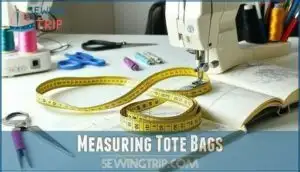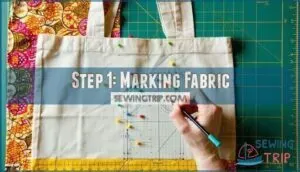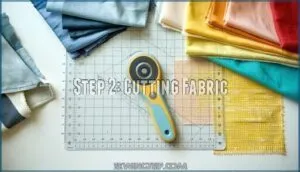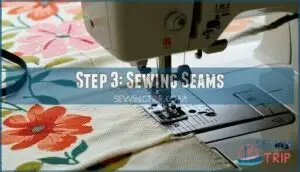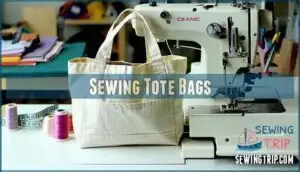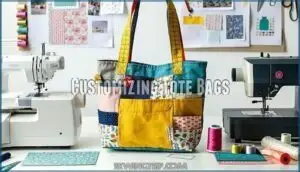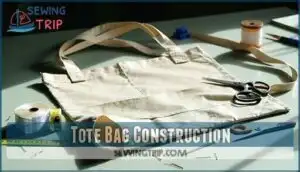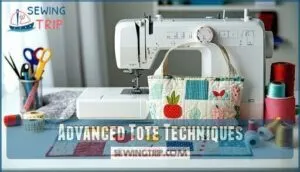This site is supported by our readers. We may earn a commission, at no cost to you, if you purchase through links.

Start with cotton or canvas fabric, measure your desired dimensions, and cut according to your pattern. You’ll sew the main body, attach sturdy straps, and add interior pockets for organization.
These beginner-friendly projects require only a sewing machine, scissors, and straight stitches. Whether you’re making grocery bags or beach totes, the process stays surprisingly straightforward.
The real magic happens when you discover professional finishing techniques that make your homemade bags look store-bought. This is where you can add a touch of DIY sewing expertise and create bags with basic yet functional designs.
Table Of Contents
Key Takeaways
- Choose durable fabrics like cotton canvas or denim – You’ll need sturdy materials that can handle daily use and washing without stretching or tearing at stress points.
- Master basic construction with boxed corners and French seams – You’ll create professional-looking bags by cutting 2"x2" corner squares for depth and using enclosed seams that hide raw edges.
- Get your measurements right from the start – You’ll need 17"x15" rectangles for the main body and 21" straps for comfortable shoulder carrying, plus ½" seam allowances throughout.
- Add functional features like interior pockets and reinforced straps – You’ll transform basic totes into organized accessories by sewing 8"x10" inside pockets and using X-shaped stitching at strap attachment points.
Tote Bag Basics
Tote bags have evolved from simple utility carriers to stylish accessories that blend function with fashion.
You’ll discover how these versatile bags can serve everything from grocery shopping to beach trips.
Transform your everyday routine with a versatile companion that handles everything from market runs to weekend adventures.
While learning the basic construction techniques that make them both durable and customizable.
History of Tote Bags
You’ve likely carried tote bags without knowing their fascinating Ancient Origins.
The term "tote" emerged in 1677 Virginia, meaning "to carry."
These Market Bags started as L.L. Bean’s ice carriers in 1944, made from sturdy canvas.
Their Modern Evolution began in the 1960s when Designer Totes became fashion statements.
The Cultural Impact grew as environmental movements promoted recycled cotton canvas and ecofriendly materials, transforming simple fabric tote bags into symbols of sustainable fashion.
Later, custom totes allowed wearers to express their individuality, much like the Strand bookstore’s design.
Types of Tote Bags
You’ll find all sorts of tote bags out there, from sturdy Market Bags to roomy Beach Totes.
Messenger Totes and Crossbody Totes keep your hands free, while Drawstring Totes are great for quick trips.
Fabric tote bags are perfect for DIY tote bag projects—just grab a free tote bag pattern and start experimenting with different tote bag patterns and fabrics.
Many people find that canvas tote bags are ideal for everyday use, making them a great choice for a versatile and practical tote.
Uses of Tote Bags
You’ve seen the different tote bags out there, but let’s talk about putting them to work.
Use your DIY tote bag for Grocery Shopping, hauling Library Books, or as a sturdy Beach Trips buddy.
Handmade tote bags shine as a Travel Companion or Everyday Carry.
Swap out plastic with a reusable shopping bag—tote bags make errands and adventures simple.
Choosing Fabric
Selecting the right fabric makes the difference between a tote that lasts for years and one that falls apart after a few shopping trips.
You’ll want to choose sturdy materials like cotton canvas, denim, or mid-weight linen that can handle daily use without stretching or tearing.
Cotton Fabric
Cotton fabric offers the perfect balance for DIY tote bag projects.
Cotton durability makes it ideal for everyday use, while cotton weaves provide structure without bulk.
Organic cotton gives you eco-friendly options, and cotton blends add stretch or water resistance.
Cotton print fabrics let you express your style—from florals to geometrics.
You can find various pre-made cotton totes for simpler projects.
This versatile material handles machine washing beautifully and won’t break your budget for fabric bags tutorial projects, making it a great choice for DIY tote bag and everyday use.
Canvas Fabric
Canvas stands as the heavyweight champion for DIY tote bag projects.
This sturdy cotton weave offers unmatched canvas durability that’ll handle heavy groceries without breaking a sweat.
Look for 5-10oz canvas weight – lighter feels flimsy, heavier becomes wrestling practice.
Canvas treatment affects your fabric bags tutorial success, so choose pre-washed options.
Understanding different canvas materials can substantially impact your project.
Canvas sourcing from quilting shops guarantees quality, while canvas printing lets you customize your DIY tote bag with patterns that won’t fade after washing.
Recycled Fabric
You’ll discover that recycled canvas fabric and other upcycled materials bring fresh life to your DIY reusable bags while supporting sustainable sewing practices.
Fabric sourcing from textile waste reduces environmental impact through ecocconscious crafting. These materials offer unique textures and patterns that make each tote special.
You can find a variety of recycled canvas options. Sewing for sustainability means choosing eco-friendly dyes and upcycling techniques that transform discarded fabrics into functional, stylish bags.
Sewing Tools Needed
You’ll need a few essential tools to create professional-looking tote bags that last.
A reliable sewing machine, sharp fabric scissors, and a rotary cutter with cutting mat will handle most projects efficiently.
Sewing Machine
Your sewing machine forms the backbone of every DIY bags project.
Before starting tote tutorials for beginners, check your machine maintenance schedule and clean lint from the bobbin area.
Select appropriate needles for your fabric weight—universal needles work for most cotton and canvas materials.
Adjust stitch settings to a medium straight stitch length and test tension adjustment on fabric scraps.
Keep essential foot attachments nearby for different seaming techniques, using the right tools for a successful project with your sewing machine.
Rotary Cutter
A rotary cutter’s sharp circular blade slices through fabric with precision that scissors can’t match.
You’ll cut multiple layers effortlessly, making DIY bags and tote bag DIY projects faster. Choose ergonomic handles for comfort during long sewing tutorials.
Practice blade safety by keeping guards closed when not in use. Regular rotary maintenance keeps cuts clean for your easy sewing projects and beginner sewing adventures.
For peak performance, consider using titanium coated blades for enhanced durability, ensuring peak performance and a better sewing experience with easy sewing projects.
Scissors
While your rotary cutter handles long, straight lines, sharp scissors tackle the detailed work.
You’ll need fabric scissors for precise cuts and small embroidery scissors for snipping threads. Keep them sharp – dull blades create frayed edges that’ll haunt your tote bag DIY projects.
Invest in ergonomic scissors if you’re planning multiple sewing tutorials. Clean blades after each project to maintain cutting performance for all your sewing projects bags.
Measuring Tote Bags
Getting your measurements right is the difference between a bag that works perfectly and one that sits unused in your closet.
You’ll need to determine three key dimensions: the main bag size, strap length for comfortable carrying, and pocket dimensions that actually hold your essentials, which are complete concepts to ensure your bag is functional.
Length and Width
Getting bag dimensions right sets you up for sewing success. Start by measuring your fabric width to determine how many pieces you’ll cut from your material. Standard tote bag dimensions work well for most sewing tutorials.
- Main body pieces: Cut two rectangles at 17" x 15" for a roomy DIY tote bag
- Seam allowance planning: Add ½" extra to each measurement for clean finished edges
- Pocket depth considerations: Mark interior pocket placement 4" from top edge before cutting
Your bag dimensions directly affect fabric width requirements. Most sewing projects bags need at least 45" wide fabric to accommodate pattern pieces efficiently. Plan your cuts carefully—you’ll thank yourself when assembling your bag making tutorial masterpiece.
Strap Length
Comfort begins with your strap’s ideal length, which typically measures 21 inches for shoulder straps.
This measurement guarantees crossbody straps won’t dig into your neck while providing adequate shoulder comfort.
Adjustable hardware lets you customize fit, but proper strap reinforcement prevents stretching over time.
| Strap Type | Ideal Length | Comfort Level | Best Use |
|---|---|---|---|
| Short Handle | 8-10 inches | Hand carry | Quick errands |
| Shoulder Strap | 21-24 inches | Medium | Daily use |
| Crossbody | 26-30 inches | High | Hands-free |
| Adjustable | 18-32 inches | Variable | Multi-purpose |
When cutting fabric straps for DIY tote bag projects, add two inches to your desired finished length.
This extra fabric accommodates seam allowances and attachment points.
Sewing tutorials often recommend testing strap length with measuring tape before cutting your final pieces, to ensure a comfortable fit and proper adjustment.
Pocket Size
Pocket dimensions depend on what you’ll carry in your DIY tote bag. An inside pocket measuring 8" x 10" works well for most items, while a phone pocket needs about 4" x 6".
Consider pocket depth carefully—shallow pockets let items fall out easily.
- Phone pocket: Keep it 4-6 inches wide for easy access during your sewing bag tutorial
- Zippered pocket: Make it 6-8 inches for secure storage of keys and cards
- Hidden pockets: Place them 2-3 inches from the top seam for discretion
Your easy tote pattern becomes more functional when pocket dimensions match your daily needs. This sewing for beginners approach guarantees every pocket serves a purpose.
DIY Tote Pattern
Creating your own tote bag pattern starts with three essential steps that transform plain fabric into a functional bag.
You’ll mark your measurements, cut precisely, and sew strong seams that can handle daily use.
Step 1: Marking Fabric
Once you’ve determined your tote measurements, grab your fabric marking pens and get ready for accurate marking.
Place your fabric on a fabric cutting mat with the wrong side facing up. Use sewing pins to secure your pattern pieces, ensuring proper pattern placement.
Mark all cutting lines, seam allowances, and strap positions with fabric marking pens. Double-check your sewing measurements before moving forward—precision here saves headaches later.
Step 2: Cutting Fabric
After marking your fabric pieces, grab your rotary cutter and fabric cutting mat for precise cuts.
Follow the fabric grain direction when cutting to prevent stretching.
Place pattern pieces efficiently to minimize waste reduction.
Use sharp cutting tools for clean edges that won’t fray.
Double-check your sewing measurements before cutting – accuracy here saves headaches later when assembling different fabric types.
For added durability, consider fabric weight capacity when selecting materials, ensuring the right fabric weight for your project, and ultimately affecting the durability and overall quality of your work.
Step 3: Sewing Seams
With precision guiding your needle, you’ll transform fabric pieces into a sturdy tote through careful seam construction.
Start with a standard ¼-inch seam allowance and use straight stitches for basic bag construction. Focus on reinforcing seams at stress points where handles attach.
- Side seams create the bag’s structure, requiring backstitch reinforcement at top edges
- Bottom seams need French seam techniques for clean, durable finishes that won’t fray
- Corner techniques involve pinching fabric to form boxed corners, creating a flat base
These sewing techniques guarantee your step-by-step instructions produce professional results.
Sewing Tote Bags
Now you’ll transform your tote bag pieces into a functional accessory through three essential sewing steps.
You’ll master the main bag construction, create useful interior pockets, and craft sturdy straps that can handle daily use, which will help you achieve a functional accessory.
Sewing Main Bag
Now you’ll place the fabric pieces with right sides together and create the foundation of your DIY tote bag.
Pin the outer fabric rectangles along the sides and bottom, maintaining consistent seam allowances of ½ inch.
Sew these seams using your machine, then press them open for a professional finish.
This careful fabric folding and stitching creates the main structure before adding topstitching techniques and corner reinforcement in later steps.
| Step | Action | Details |
|---|---|---|
| 1 | Pin Fabric | Place outer pieces right sides together, align edges |
| 2 | Sew Seams | Stitch ½" seam allowances on sides and bottom |
| 3 | Press Open | Iron seams flat for clean, professional appearance |
Sewing Inside Pocket
Adding an inside pocket transforms your DIY tote bag from basic to brilliant. This functional feature keeps small items secure and organized within your handmade masterpiece.
Here’s your step-by-step approach:
- Cut pocket fabric – Use an 8" x 10" piece, fold top edge down 1", and press
- Position carefully – Place pocket 3" from top seam on liner fabric before assembly
- Secure edges – Pin three sides, leaving top folded edge open for access
- Stitch precisely – Sew ¼" seam around pinned edges, backstitch at corners for strength
For patch pockets, simply topstitch the finished piece onto your bag’s interior. Zippered pockets require installing the zipper before attaching. Consider pocket placement based on your needs – side pockets work great for phones, while centered pockets hold larger items. Hidden pockets can be sewn into seam allowances for valuables. This sewing tutorial for beginners makes adding functionality easy, turning your free tote bag pattern into a custom storage solution.
Sewing Straps
Once your pocket’s stitched in, it’s time to tackle the straps.
Fold your canvas straps or reinforced fabric strips lengthwise for comfortable straps. Sew along both edges for strength—think strap reinforcement here.
Adjust strap length for a shoulder strap or short bag handles. Try adjustable straps or strap alternatives like webbing.
Double-stitch at attachment points for sturdy, reliable handles.
Customizing Tote Bags
You can transform any basic tote bag into a unique, functional accessory by adding personal touches that match your style and needs.
Simple modifications like pockets, decorative straps, or custom embroidery turn a plain tote into something special that’s truly yours.
Adding Pockets
Now you can easily transform your basic tote bags into organized workhorses.
Pockets provide practical storage solutions that keep your essentials accessible and secure. Whether you’re creating your first DIY sewing tutorials project or perfecting advanced techniques, pocket placement makes all the difference.
- Patch Pockets: Cut an 8" x 10" rectangle, fold edges under, and topstitch directly onto your bag’s exterior or interior
- Zippered Pockets: Install between lining layers for secure storage of valuables and small items
- Inset Pockets: Create flush openings by cutting bag fabric and inserting pocket pieces during construction
- Pocket Dividers: Add vertical stitching lines through patch pockets to separate pens, phones, and cards
Adding Straps
Strap reinforcement starts with choosing the right materials. You’ll need strong fabric strips or webbing for handles that won’t tear under weight.
Cut your shoulder straps 21 inches long for comfortable carrying. Adjustable straps work great with slide buckles – just thread them through and position for perfect fit.
Consider strap placement carefully, marking 4 inches from side seams for balance. When sewing straps to tote bags, use X-shaped stitching or bar tacks for maximum strength in your DIY sewing tutorials.
Embroidery Designs
Embroidery transforms plain handmade bags into personalized masterpieces.
Start with simple embroidery stitches like French knots or satin stitch for beginners.
Choose design transfer methods using iron-on patterns or water-soluble stabilizers.
Thread selection matters—polyester offers durability while cotton provides natural appeal.
Color palettes should complement your tote’s fabric.
Pattern inspiration ranges from floral motifs to geometric designs, making bag customization endless through sewing tutorials for beginners.
Tote Bag Construction
Now you’ll master the structural elements that make your tote bag durable and professional-looking.
These three techniques—boxed corners, French seams, and interfacing—transform a simple fabric rectangle into a sturdy, long-lasting bag.
That can handle daily use, making it a professional-looking bag that is perfect for various tasks.
Boxed Corners
Boxed corners transform flat tote bags into sturdy, three-dimensional carriers that’ll actually stand upright on your counter.
You’ll create these by snipping 2"x2" squares from each bottom corner, then pinching and sewing across the gap.
The Corner Depth you choose affects your bag’s capacity, while proper Seam Allowance guarantees durability.
Smart Fabric Choice matters here—canvas handles this technique beautifully.
- Corner Depth determines volume: Larger corner cuts create wider bag bases but reduce height
- Reinforcement Methods include double-stitching the corner seams: This prevents stress tears during heavy use
- Alternative Shapes work too: Try triangular or rounded corner cuts for unique bag profiles
- Precision cutting prevents puckering: Mark your squares carefully before snipping for professional results
French Seams
With French seams, you’ll create professional-looking tote bags that rival store-bought versions.
These enclosed seams hide raw edges completely, giving your DIY tote bags clean interiors without visible fraying.
Start by sewing pieces wrong sides together, then trim seam allowances and flip right sides together for a second seam.
This sewing technique reduces bulk while boosting seam durability—perfect for bag sewing tutorials focusing on longevity, and it results in a clean finish with professional-looking tote bags.
Interfacing
Interfacing transforms flimsy fabric into professional-looking tote bags.
Choose fusible types for easy application—just iron onto your fabric’s wrong side.
Interfacing weight matters: medium-weight works best for most DIY fabric totes.
This stabilizing fabric prevents sagging and maintains shape.
Consider interfacing alternatives like canvas or batting for unique textures in your sewing projects.
For enhanced support, consider how fabric grain matching affects drape.
Tote Bag Features
You can transform a basic tote bag into something special by adding adjustable straps, zippered compartments, and exterior pockets.
These features make your handmade bag more functional and help it compete with store-bought options.
Adjustable Straps
Creating adjustable straps transforms your tote from basic to brilliant. You’ll need adjustable slide buckles and strap hardware for weight distribution that keeps your shoulders happy.
These features let you customize strap length for different carrying styles and comfort factors.
- Thread webbing through sliding buckles – Position the adjustable buckle 6 inches from the bag attachment point for maximum adjustment range
- Reinforce connection points – Use box stitching or bar tacks at handles where straps meet the bag body for maximum durability
- Test weight capacity – Load your finished bag with typical items to guarantee the adjustable mechanisms hold securely under stress
Follow a step-by-step video tutorial for proper buckle installation techniques.
These sewing tips guarantee your adjustable system won’t fail when you need it most.
Zippered Interiors
Adding a zippered interior transforms your tote’s functionality, creating secure storage for valuables. This zippered closure keeps items protected while maintaining easy access. A lining zipper installation requires careful planning but delivers professional results.
| Zipper Type | Best Use |
|---|---|
| Standard coil zipper | General zippered pocket applications |
| Heavy-duty metal zipper | Secure zipper for frequent use |
| Invisible zipper | Clean zippered pouch appearance |
| Two-way zipper | Large zippered closure access |
| Waterproof zipper | Weather-resistant lining protection |
Follow sewing tutorials online for proper zipper installation techniques. Position your zippered pocket before attaching the lining to guarantee smooth operation. Practice sewing pockets on fabric scraps first to master the inside pocket construction process.
Exterior Pockets
You’ll want to map out pocket placement before cutting any fabric, as exterior pockets can completely transform your tote’s functionality.
Patch pockets offer the simplest approach—just cut rectangular pieces and topstitch them onto your main fabric panels.
For zippered pockets, consider flap closures that protect contents while adding visual interest.
Different pocket shapes like curved corners or angled edges can complement your tote’s style perfectly.
Advanced Tote Techniques
Now that you’ve mastered the basics, you can try advanced tote techniques like quilting, applique, and stabilizing fabric for extra structure.
These methods help your tote bags look more professional and hold up better, even when you pack them full of library books or snacks.
Quilting
Quilted panels transform ordinary tote bags into structured masterpieces.
Dense quilting patterns boost bag strength by 40% compared to non-quilted versions.
Choose your batting wisely—it determines your bag’s final feel and durability.
- Quilted Panels: Layer fabric, batting, and backing for triple-strength construction
- Fabric Selection: Pick cotton canvas that won’t pucker under dense stitching
- Quilting Designs: Try geometric patterns or free-motion florals for visual impact
- Batting Choice: Select medium-weight batting for structure without bulk
- Binding Methods: Use walking foot attachments for even fabric feeding
Walking foot attachments prevent fabric bunching during machine quilting.
Your DIY sewing projects gain professional polish when you master these quilting fundamentals for bag making.
Applique
After quilting, let’s talk applique. This technique lets you personalize tote bags with bold applique shapes and creative design placement.
Choose sturdy fabric selection for your patches, then use zigzag or satin stitch types to control fraying.
Fused applique saves time in DIY sewing. Remember, securing applique with careful stitching is key.
Explore sewing tutorials for more bag making inspiration and sewing patterns.
Stabilizing Fabric
Three key tricks help your tote bag stand tall: pick the right interfacing types for your fabric, try fusible fleece or batting structure for extra shape, and don’t shy from doubled layers or quilted construction.
Stiff interfacing and heavy fabric boost durability, especially when paired with heavyduty cotton thread.
Test each combo—some bags need more backbone than others, and using the right techniques, such as doubled layers, can make a significant difference.
Frequently Asked Questions (FAQs)
How do you sew an easy tote bag?
Like threading a needle of creativity, sewing a tote bag transforms fabric into function.
Cut two 18"x14" rectangles plus interfacing.
Sew sides and bottom, create boxed corners, add straps, and topstitch.
Can you sew a small tote bag?
Yes, you can sew a small tote bag.
Start with smaller fabric pieces – try 12"x10" rectangles instead of full-size.
Use the same construction techniques: cut corners for depth, add interfacing for structure, and attach straps securely with topstitching.
How to make a tote bag with a sewing machine?
Cutting precise fabric pieces is different from randomly chopping vegetables. You’ll cut two main rectangles and handle strips, then sew side seams, create straps, and topstitch for durability.
How do you decorate a tote bag?
You can personalize tote bags with fabric paint, iron-on patches, embroidery, or appliqué designs.
Add buttons, ribbons, or decorative stitching for texture.
Heat transfer vinyl creates professional-looking text and graphics easily, using heat transfer vinyl.
What to do with a tote bag?
You can use a tote bag for grocery shopping, carrying books, beach trips, gym clothes, work essentials, or daily errands. It’s perfect for organizing items while staying hands-free and stylish.
How to make a tote bag step by step for beginners?
Begin with cutting two 18"x14" fabric rectangles plus matching interfacing pieces.
Cut 21" canvas strips for handles.
Apply interfacing to outer fabric pieces, then sew sides and bottom with ½" seams, leaving corners unstitched to create depth.
What is the best stitch for a tote bag?
When push comes to shove, a straight stitch is your bread and butter for tote bags.
It’s strong and neat.
For extra muscle, double-stitch seams or try a zigzag stitch on raw edges to prevent fraying.
How to make tote bags without a sewing machine?
Grab sturdy fabric, sharp scissors, and a needle with strong thread.
Sew seams by hand with a backstitch for strength.
Pin layers together, work slowly, and double-knot threads.
It’s slow but worth every stitch.
How do you wash and care for handmade tote bags?
Like a protective shield for your treasured creation, proper care keeps handmade tote bags looking fresh.
Pre-treat stains, wash in cold water on gentle cycle, air dry flat, and iron on medium heat to maintain fabric integrity and shape, ensuring the bag retains its original look and fresh appearance.
How much does it cost to make a DIY tote?
A DIY tote bag typically costs $5-15 to make, depending on your fabric choice.
You’ll spend less using remnants or repurposed materials, while premium canvas or designer fabrics increase costs substantially.
Conclusion
Sarah turned her old bedsheets into stunning market totes that friends mistake for designer bags.
Now you’re equipped with thorough DIY sewing tutorials bags totes knowledge to create your own professional-looking accessories.
You’ve learned fabric selection, proper measurements, and construction techniques that transform basic materials into functional masterpieces.
Start with simple designs, then progress to advanced features like zippered compartments and reinforced corners.
Your homemade totes will soon rival store-bought alternatives while reflecting your personal style and creativity.
- https://sewcanshe.com/bag-lovers-rejoice-over-50-free-patterns-await-you/
- https://www.youtube.com/watch?v=AwD58_Pu5Kw
- https://threadsmonthly.com/tote-bag-sewing-patterns/
- https://littlestitchstudio.com/blog/2019/8/26/the-best-fabrics-for-bag-making
- https://www.polkadotchair.com/15-must-know-bag-making-tips-and-tricks/





